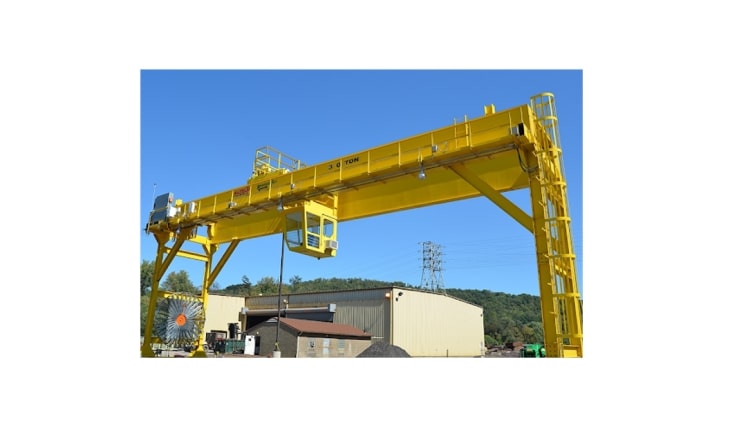Gantry Cranes: An Overview
A gantry crane is an overhead crane with one or two legs that travel on wheels or along a track/rail line and can have a single or double girder configuration. Gantry cranes do not need to be built into the construction of a building and are frequently used when an overhead runway structure is not feasible. This piece of machinery is necessary for a variety of industrial applications. Although there are various other types of overhead cranes available, gantry cranes offer certain distinct advantages.
This article will go over how these cranes function, as well as their uses and advantages. We’ll also discuss the different types of mobile handling gantry cranes on the market and what to look for when purchasing one. Keep reading to learn more!
How does a Gantry Crane work?
Gantry cranes generally feature one or two inverted V-shaped legs connected by a cross-beam. The crane’s top cross beam may accommodate a variety of lifting mechanisms. To change positions, the lifting device on bigger versions may slide back and forth on the top cross-beam. Many Gantry crane models have wheels or a track/rail system. The crane can now move objects in three dimensions.
In construction, what is a gantry?
Gantry cranes aren’t the only ones who use the name. This is a structure with two legs and a cross beam that suspends an object by straddling it on said cross beam in construction. Small gantries can be used to assist the display of domestic objects in a home. They are medium-sized and can be used to hold up event décor. They may be rather huge, and they’re used for things like road signs, railway signage, electricity infrastructure, and, of course, cranes.
What are the Applications of Gantry Cranes?
Gantry cranes are the workhorse of any industry that requires repetitive lifting. They can be found working at small workshops and warehouses, to major rail yards all over town–even on boats. Gantry cranes have the advantage of being able to work both indoors and outdoors. Small gantry cranes are usually moveable, whilst bigger models are usually permanent.
Overhead Cranes vs. Gantry Cranes
All overhead cranes operate on the same principles. Gantry cranes are distinguished by a few characteristics, one of which is their mobility. Other cranes must normally be attached to the structure in which they are stored. Gantry cranes, on the other hand, have their own support framework and may be moved throughout your facility. They can also be quickly erected and dismantled, which is advantageous for developing companies that need to move equipment around in their warehouses. These are available in three different designs.
Fixed Height Gantries are built to a specified height for a particular use.
Adjustable Gantries – Height may be changed according to requirements.
Portable Gantries are used to operate on large machinery in repair and maintenance situations. They can be dismantled, relocated, and reconstructed with little effort.
Benefits and Applications of Gantry Cranes
There are various advantages to using a gantry crane. They are extremely durable and may be utilized in a broad range of situations. They are the most popular type of overhead crane because they don’t require any additional support structures.This is frequently expensive and restricts the crane’s use indoors. Gantry cranes do not require any additional support structures because they are self-supporting. This saves the owners time and money both during installation and later if it needs to be removed.
The Gantry crane is adaptable to any environment, and can be used both indoors or outdoors. The ease of usage is also a significant factor. These cranes may be controlled remotely or manually, giving personnel on the ground more options. Its maintenance is low due to its basic design, saving the owners time and money. Gantry cranes are also energy efficient, assisting users in achieving more sustainable company operations.
Different types of mobile handling gantry cranes on the market
There are several different types of mobile handling gantry cranes on the market. The most common type is the telescopic crane, which is composed of a boom that can be extended and retracted.
Another type of mobile handling gantry crane is the articulated crane. This type of crane has a boom that is hinged in the middle, allowing it to reach around obstacles.
There are also portal cranes, which are similar to gantry cranes but have an A-frame instead of a boom.
No matter what type of mobile handling gantry crane you need, it is important to make sure that you purchase one from a reputable manufacturer.
What to look for when purchasing mobile handling gantry cranes
When it comes to purchasing a mobile handling gantry crane, there are several key factors that you will need to take into account in order to ensure that you make the best possible purchase.
One of the most important things to look for when purchasing a mobile handling gantry crane is the quality of the crane itself.
In addition to the quality of the crane, you will also want to consider the price. Mobile handling gantry cranes can range in price quite a bit, so it is important to find one that fits within your budget.
Finally, you will also want to consider the warranty that is offered with the crane. Most reputable manufacturers offer some sort of warranty on their products, so be sure to find out what is available. This can help you avoid any unexpected expenses down the line.
Bottom Line
Mobile handling gantry cranes are a great investment for any business that needs to move heavy loads on a regular basis. So, if you are in the market for a mobile handling gantry crane, be sure to consider all of your options and make the best decision for your company.

